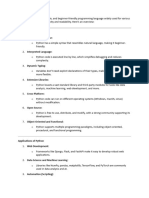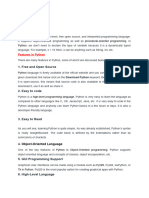Python
Uploaded by
Anilkumar GPython
Uploaded by
Anilkumar GPython is a high-level, interpreted programming language known for its simplicity and versatility.
Created
by Guido van Rossum and first released in 1991, Python's design philosophy emphasizes code readability
and syntax that allows programmers to express concepts in fewer lines of code compared to languages
like C++ or Java.
## Key Features of Python
### 1. **Easy to Learn and Use**
Python's syntax is clear and intuitive, making it an ideal language for beginners. It employs English
keywords frequently, and its structure is straightforward, which reduces the learning curve.
### 2. **Interpreted Language**
Python is an interpreted language, meaning the code is executed line-by-line. This makes debugging
easier and more interactive since you can test code snippets on the fly without needing to compile the
entire program.
### 3. **Dynamically Typed**
Variables in Python do not require an explicit declaration to reserve memory space. The declaration
happens automatically when you assign a value to a variable, which can change type as needed. This
flexibility can speed up development but requires careful management to avoid type-related bugs.
### 4. **Object-Oriented**
Python supports object-oriented programming (OOP), which allows for the creation of reusable code and
structures like classes and objects. OOP principles such as inheritance, encapsulation, and polymorphism
are integral to Python, enabling developers to create complex applications with clear, modular code.
### 5. **Extensive Standard Library**
Python comes with a rich standard library that provides modules and functions for tasks such as file I/O,
system calls, and even Internet protocols. This extensive library means you can accomplish a lot without
needing external libraries.
### 6. **Cross-Platform Compatibility**
Python is available on many operating systems, including Windows, macOS, and various distributions of
Linux. This cross-platform capability allows developers to write code that works on multiple platforms
with little to no modification.
### 7. **Community Support and Libraries**
Python boasts a large and active community, which contributes to a wealth of third-party libraries and
frameworks. Libraries like NumPy, Pandas, and Matplotlib are essential for scientific computing and data
analysis. Frameworks such as Django and Flask are popular for web development, while TensorFlow and
PyTorch are widely used for machine learning.
### 8. **Integration Capabilities**
Python can be easily integrated with other languages and technologies. For instance, you can use Cython
to compile Python code into C for performance improvements or use Jython to run Python on the Java
platform.
### 9. **Automated Memory Management**
Python uses an automatic garbage collector to manage memory allocation and deallocation. This feature
helps prevent memory leaks and other issues related to manual memory management.
## Popular Uses of Python
### 1. **Web Development**
Frameworks like Django and Flask make Python an excellent choice for developing robust and scalable
web applications. Django is known for its "batteries-included" approach, offering a lot of built-in
features, while Flask provides a micro-framework that is lightweight and flexible.
### 2. **Data Science and Machine Learning**
Python's libraries such as NumPy, Pandas, Scikit-learn, TensorFlow, and PyTorch have made it a leading
language in data science and machine learning. These tools allow for efficient data manipulation,
analysis, and the creation of complex machine learning models.
### 3. **Automation and Scripting**
Python is often used for writing scripts to automate repetitive tasks. Its simplicity and ease of use make it
ideal for tasks like web scraping, file manipulation, and batch processing.
### 4. **Software Development**
Python is a common choice for developing software and applications. Its ability to handle complex
calculations and algorithms, combined with its readability, makes it suitable for both small-scale and
large-scale projects.
### 5. **Education**
Python's clear syntax and readability make it an excellent language for teaching programming and
computer science fundamentals. Many educational institutions use Python as the introductory language
for new programmers.
In conclusion, Python's versatility, ease of use, and powerful libraries make it a go-to language for a wide
range of applications, from web development to data science. Its active community and continuous
development ensure that Python remains a relevant and valuable tool for programmers of all skill levels.
You might also like
- The forest was alive with the sound of rustling leaves and the occasional snap of a twig underfootNo ratings yetThe forest was alive with the sound of rustling leaves and the occasional snap of a twig underfoot3 pages
- Module 1 Introduction To Python - AssignmentNo ratings yetModule 1 Introduction To Python - Assignment6 pages
- Essential Guide To Python For All Levels (2024 CollectionNo ratings yetEssential Guide To Python For All Levels (2024 Collection184 pages
- Python_ Advantages, Diversification, and Future-Proofing - Google DocsNo ratings yetPython_ Advantages, Diversification, and Future-Proofing - Google Docs45 pages
- What Are The Major Uses of Python in 2022No ratings yetWhat Are The Major Uses of Python in 20223 pages
- Web-and-Mobile-Applications-Development-1No ratings yetWeb-and-Mobile-Applications-Development-112 pages
- Practical Guide to Python: From Basics to Advanced ProgrammingFrom EverandPractical Guide to Python: From Basics to Advanced ProgrammingNo ratings yet
- 1.2 Linear Equations and Rational Equations: SectionNo ratings yet1.2 Linear Equations and Rational Equations: Section15 pages
- Multithreading Interview Questions: Click HereNo ratings yetMultithreading Interview Questions: Click Here37 pages
- Richard Podos and Lance LLC Lawsuit Regarding Proprietary Structure For Tenant Improvement FinancingNo ratings yetRichard Podos and Lance LLC Lawsuit Regarding Proprietary Structure For Tenant Improvement Financing15 pages
- 3.3 Characteristics of Polynomial Functions in Factored FormNo ratings yet3.3 Characteristics of Polynomial Functions in Factored Form3 pages
- Information Retrieval Algorithms: A Survey: Prabhakar RaghavanNo ratings yetInformation Retrieval Algorithms: A Survey: Prabhakar Raghavan8 pages
- Products Affected / Serial Numbers Affected:: TP17 212.pdf 08-11-17No ratings yetProducts Affected / Serial Numbers Affected:: TP17 212.pdf 08-11-174 pages

























































































